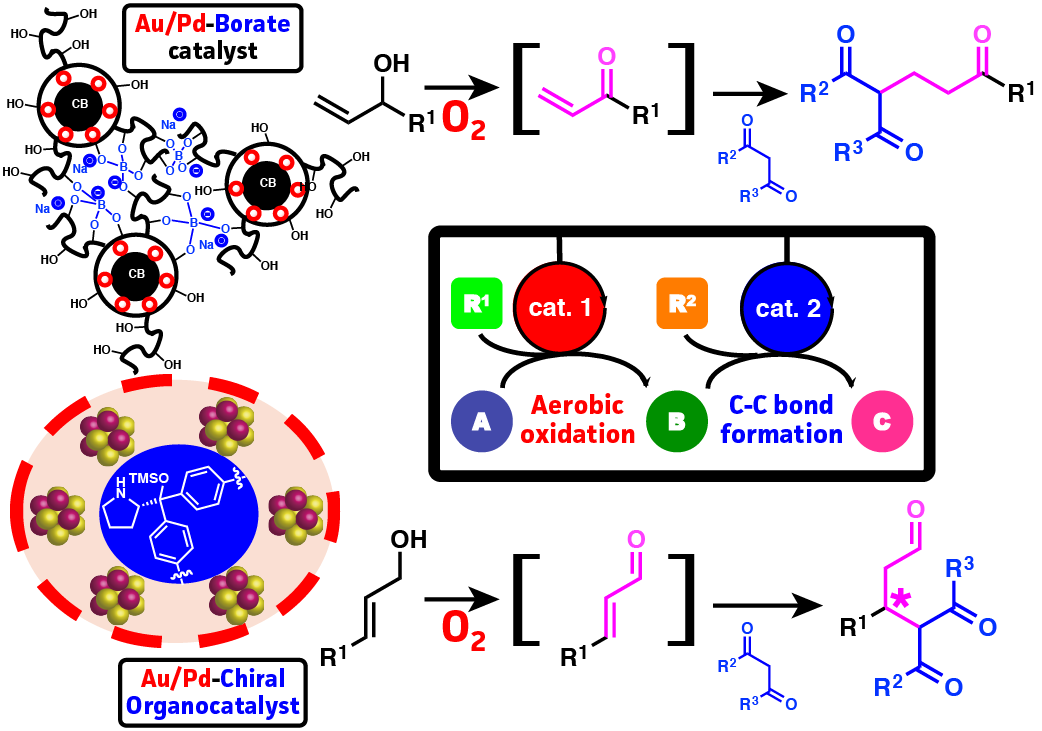
Tandem reactions using multifunctional heterogeneous catalysts
Heterogeneous catalysis and one-pot tandem reactions are key for efficient and practical organic syntheses and for green and sustainable chemistry. Heterogeneous catalysts can be recovered and reused. These catalysts can be applied to efficient systems, such as continuous-flow systems. Tandem reactions often proceed via highly reactive but un- stable intermediates. Tandem reactions do not require workup or much purification of the intermediate. This Account summarizes recent developments that we have made in the field of multifunctional heterogeneous metal nanocluster catalysts for use in tandem reactions based on aerobic oxidation reactions as key processes. We constructed our heterogeneous metal nanoclusters via two important procedures microencapsulation and cross-linking using polystyrene-based copolymers with cross-linking moieties. These frameworks can efficiently stabilize small metal nanoclusters to maintain high catalytic activity without aggregation and leaching of nanoclusters. Aggregation and leaching are prevented by weak but multiple interactions between metal nanocluster surfaces and benzene rings in the copolymer as well as by the physical envelopment of cross-linked polymer backbones. Small nanoclusters, including multimetallic alloy clusters (nanoalloys), can be “imprisoned” into these cross- linked polymer composites. The term we use for these processes is polymer incarceration. Direct oxidative esterifications were achieved with polymer-incarcerated (PI) Au nanocluster catalysts. Amides were synthesized from alcohols and amines under aerobic oxidative conditions with PI bimetallic nanocluster catalysts composed of Au and Fe-group metals that formed separated nanoclusters rather than alloys. Oxidative lactam formation from amino alcohols was also achieved. On the other hand, imines could be prepared selectively from alcohols and amines with PI Au−Pd bimetallic nanoclusters. We also achieved the integration of the aerobic oxidation of allylic alcohols and the following Michael reaction catalyzed by trimetallic PI catalysts containing Au−Pd alloy nanoclusters and tetraalkoxyborates as cross-linkers. All of these heterogeneous catalysts could be recovered by simple operations and reused without significant loss of activity or any leaching of metals. We have demonstrated that the polymer incarceration method enables the simultaneous immobilization of several metals, with which we can achieve one-pot tandem oxidative processes using molecular oxygen as an oxidant within the multifunctional heterogeneous catalysts. Suitable choices of metals and bimetallic structures are crucial for the reactivity and the selection of reaction pathways.
Review:
- Tandem Oxidative Processes Catalyzed by Polymer-Incarcerated Multimetallic Nanoclusters with Molecular Oxygen
- Miyamura, H.; Kobayashi, S.
- Acc. Chem. Res. , 47, 1054(2014). DOI: 10.1021/ar400224f

